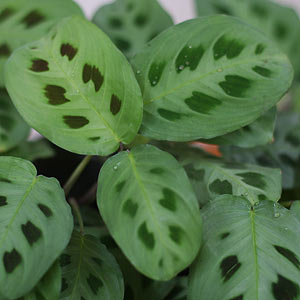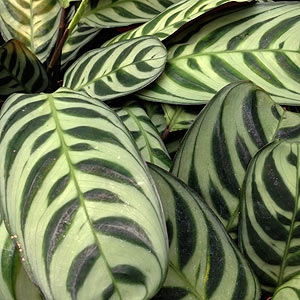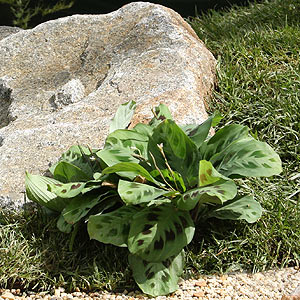The Prayer Plant

Many householders are familiar with the prayer plant, and they are not difficult to grow. Given the right light, moisture and temperature they will thrive.
Grown widely as a house plant, however also suited to outdoors in the right climate the botanical name is Maranta leucoreura and it is commonly called the “prayer plant”.
A number of named cultivars with different leaf patterns are sold. However all have the same trait of folding their leaves together at night, hence the common name.
It is also know as the rabbit-track plant, after the pattern on the foliage. According to the ASPCA, prayer plants are non-toxic to both dogs and cats.
Care
How to Grow the Prayer Plant.

These are a tropical to subtropical understory plant, they like bright filtered light, humidity and moisture.
This is easily achieved indoors, the heat of a normal home will be suitable, it is the humidity that will need a boost.
Humidity can be increased by using a saucer of water beneath the pot.
The saucer is filled with stones, the potted “Prayer Plant’ sits on top of the stones, and above the water.
The humidity created by the water evaporating helps plant growth. You can use humidifiers and misting systems if needed.
- Grow them indoors and keep the temperature between 60F at night and 80F in the day.
- In winter when growth slows the growing medium itself needs to be allowed to dry a little, however the humidity will still needs to be kept high.
- If you are going to mist, remember that it is the air that needs to be humid, so spray the air around there plants, not the foliage itself. Always mist in the mornings so that the foliage will dry before the evening.
- Water used should be rainwater rather than tap water. Tap water can cause an excessive build up of salts.
- Avoid using fertilisers with phosphate in them to stop salt build up.

For those lucky enough to be growing these plants in the warmer zones, they will do well outdoors, they will still need filtered light, rather than strong direct sun.
Prayer plants will flower, small purple and white blooms usually in late spring to summer. However it is the foliage that lis the main attraction.
Varieties
- Maranta leuconeura var. kerchoveana
- Maranta leuconeura var. erythroneura”. has a stronger pattern on the foliage with red veins, a most desirable form.
- Maranta leuconeura var ‘Beauty Kim’ has distinctly different makings, pictured second from top.
Potting and Propagation
If you need to repot, do this in early spring as the weather warms. Any good quality commercial potting soil will do. We suggest adding some additional perlite to the mix to improve the drainage.
- Water the plants well the weeks before repotting.
- You can then tip the plant out and divide the clump.
- Stem cuttings can also be taken at this time.
- Repot the divisions in a clean pot with new potting soil
- Water well with a liquid seaweed fertiliser
Stem cuttings are the easiest method of propagation and best placed into a propagating mix which is free draining, yet water retentive. They will need extra humidity in order to survive.
Problems
- Leaves turning brown – Usually due to low humidity, however also caused by over watering.
- Leaves turning yellow – Usually caused by over watering, although some older leaves will naturally turn yellow as they die.
- Leaves not folding at night. – This is an indicator that the plant is not getting enough light. It could also indicate very wet, or very dry soil. This is also an indicator of salt build up in the potting soil. A good flush out with clean rain water can help, or repot in a new potting mix.
- Fungal Problems – Usually caused by wet foliage, avoid watering the foliage, and ensure it is dry at night.
- Root nematodes – Use a commercial nematicide.

